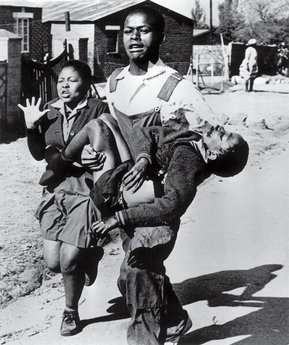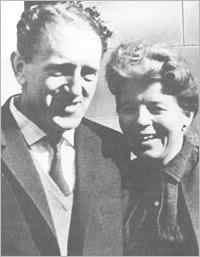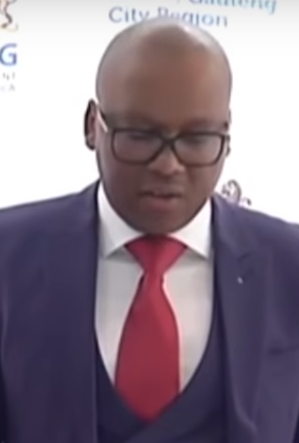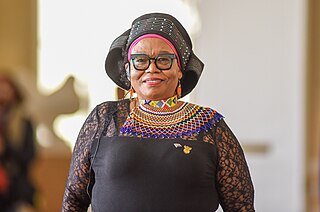
uMkhonto weSizwe was the paramilitary wing of the African National Congress (ANC), founded by Nelson Mandela in the wake of the Sharpeville massacre. Its mission was to fight against the South African government.
The Department of Bantu Education was an organization created by the National Party of South Africa in 1953. The Bantu Education Act, 1953 provided the legislative framework for this department.

The Azanian People's Organisation (AZAPO) is a South African liberation movement and political party. The organisation's two student wings are the Azanian Students' Movement (AZASM) for high school learners and the Azanian Students' Convention (AZASCO) for university level students. The organisation's women's wing is Imbeleko Women's Organisation, simply known as IMBELEKO. Its inspiration is drawn from the Black Consciousness Movement inspired philosophy of Black Consciousness developed by Steve Biko, Harry Nengwekhulu, Abram Onkgopotse Tiro, Vuyelwa Mashalaba and others, as well as Marxist Scientific Socialism.

The Soweto uprising was a series of demonstrations and protests led by black school children in South Africa during apartheid that began on the morning of 16 June 1976.
The South African Students' Organisation (SASO) was a body of black South African university students who resisted apartheid through non-violent political action. The organisation was formed in 1969 under the leadership of Steve Biko and Barney Pityana and made vital contributions to the ideology and political leadership of the Black Consciousness Movement. It was banned by the South African government in October 1977, as part of the repressive state response to the Soweto uprising.

Lionel "Rusty" Bernstein was a Jewish South African anti-apartheid activist and political prisoner. He played a key role in political organizations such as the South African Communist Party (SACP) and the African National Congress (ANC). He helped form the South African Congress of Democrats to bolster white participation in the ANC, and he brought its allies together to establish a Congress of the People, working closely with Nelson Mandela.

Thomas Titus Nkobi was a senior leader of the South African African National Congress (ANC) and a key figure in the Anti-Apartheid movement. Until his death he was the Treasurer General of the ANC and also its Member of Parliament.
Zephania Lekoame Mothopeng was a South African political activist and member of the Pan-Africanist Congress (PAC).

Internal resistance to apartheid in South Africa originated from several independent sectors of South African society and took forms ranging from social movements and passive resistance to guerrilla warfare. Mass action against the ruling National Party (NP) government, coupled with South Africa's growing international isolation and economic sanctions, were instrumental in leading to negotiations to end apartheid, which began formally in 1990 and ended with South Africa's first multiracial elections under a universal franchise in 1994.

Kate Molale OMSS was a South African political activist, between 1970 and 1975 she represented the ANC Women's League/Women's Section in the Women's International Democratic Federation.

Max Vuyisile Sisulu is a South African politician and businessman who was Speaker of the National Assembly from May 2009 to May 2014. A member of the African National Congress (ANC), he was a member of the party's National Executive Committee from December 1994 to December 2017.
Curtis Nkondo was a South African diplomat, school teacher and politician with the African National Congress. Born in Louis Trichardt, Nkondo was a lifelong activist with the ANC. He was a high school teacher at Lamula High School in Meadowlands, Gauteng and eventually became the chairman of the Soweto Teachers Action Committee before being suspended for educating against apartheid. A year after the formation of the Azanian People's Organisation (AZAPO) in 1978, in September 1979, at its conference in Roodepoort the national executive was formed with Nkondo as its president. In 1980, Nkondo was suspended by AZAPO for Breach of principle.

Morris Isaacson High School is a government secondary school in Soweto. Founded in 1956, the school took an important role at the start of the Soweto Uprising in 1976.
Jack Simons was a South African university academic and anti-apartheid activist.
Mamelodi High School, also called Mamelodi Secondary School, is a high school in Mamelodi township, Tshwane, South Africa. The school was founded in 1956 under the Department of Bantu Education of the Apartheid regime. In the 1960s it was one of only two post-primary schools in Mamelodi. The medium of instruction was Afrikaans, until the Soweto uprising in 1976, when it changed to English.
Joyce Nomafa Sikakane, later Sikakane-Rankin, is a South African journalist and activist. She was detained by the Apartheid South African government for 17 months for her anti-apartheid activism.

Bandile Edgar Wallace Masuku is a South African medical doctor and politician serving as a Member of the Gauteng Provincial Legislature since May 2019. He was the Gauteng MEC for Health from May 2019 to October 2020. Masuku is a party member of the African National Congress (ANC).
Mohammed Tikly was a South African educator and struggle veteran. A member of the ANC, he spent over thirty years in exile in the UK, Tanzania and Zambia. He was a former director of the Solomon Mahlangu Freedom College (SOMAFCO) in Tanzania.

Lindiwe Michelle Maseko is a South African politician who was appointed South African Ambassador to Venezuela in July 2022. She previously served as a Member of the National Assembly from 2014 to 2019 and as a Member of the Gauteng Provincial Legislature from 1994 to 2014; she was Speaker of the Gauteng Provincial Legislature from 2009 to 2014. She is a member of the African National Congress (ANC) and was Provincial Treasurer of the ANC in Gauteng from 2001 to 2010.
Makhosazana Abigail Alicia "Makho" Njobe is a South African politician who served in the National Assembly from 1994 to 2014, excepting a brief hiatus in 2009. She represented the African National Congress (ANC) until January 2009, when she defected to the breakaway Congress of the People (COPE). She represented COPE for her final term from 2009 to 2014. From 2009 onwards, she served the Eastern Cape constituency.











